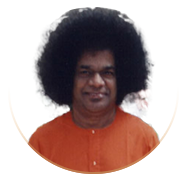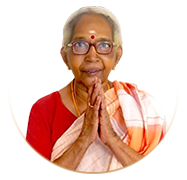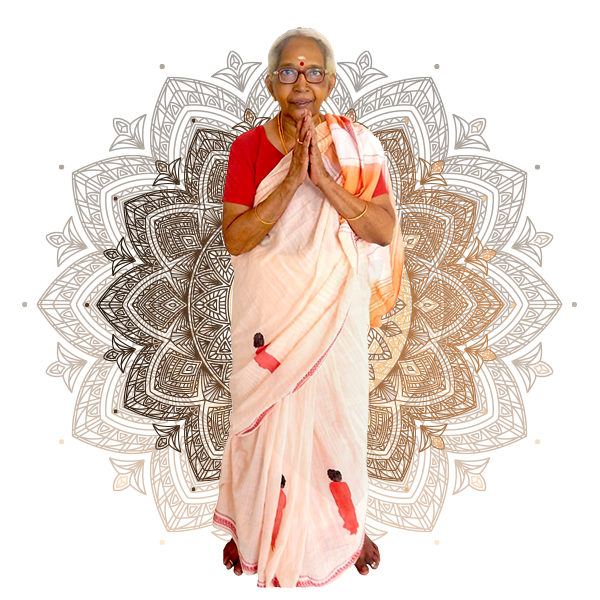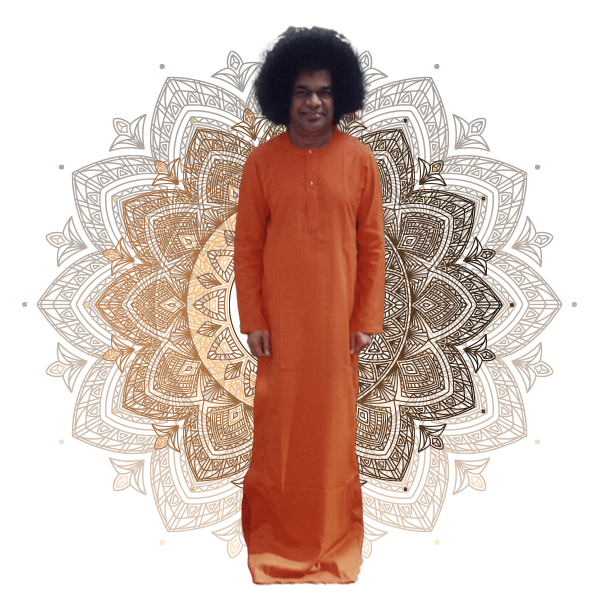DESCRIPTION
Sri Durga
Maa Durga is Adi Parashakthi, a principal form of Hindu Goddess. Her Weapon is Chakra (discus), Shankha (conch shell), Trishula (trident), Gada (mace), Bow and Arrow. Khanda (sword), Shield and Ghanta (bell). She is the consort of Lord Shiva. Durga as Mahishasura-Mardini is the slayer of the buffalo demon. She is depicted as a Goddess riding on a lion or a tiger, with many arms – each of them is carrying a weapon. She is a Goddess of war, combating evils and demonic forces that threaten peace and prosperity. She is also a fierce form of the Protective Mother who unleashes Her Divine wrath against the wicked to liberate the oppressed.
According to a Hindu tradition there are three main forms of Durga: Mahasaraswati, Mahalakshmi and Mahakali who are active energies (Shakthis) of Brahma, Vishnu and Rudra.
Sri Vasantha Sai, the Divine Consort of Sri Sathya Sai Baba, placed Her Mangalya Sutra around the neck of the idol of Durga Devi after Bhagavan had told Her to take sanyas and start Her life in the Ashram (Mukthi Nilayam).
Source: Halinka Bykowska
Durga is considered the Adi Shakti or the Primordial Power, who created the entire Universe out of her womb. An embodiment of Prakriti or the creative feminine force, Durga, the Warrior Goddess, is both fierce and compassionate. While fighting with terrible demons, she exhibits her raging side. But with devotees, she is gentle and benevolent and grants all their wishes.
Durga – the goddess of power and strength is a multi-dimensional Goddess, with many names, many personas, and many facets. As Mahishasuramardini or Shakti, she is the destroyer of evil – with her ten mighty arms carrying lethal weapons she triumphantly slays the demon Mahishasura. As Sati, beloved daughter of King Daksha and Queen Menaka she gives up a kingdom and earns her father’s wrath. As Kali, she turns black as the night and omnipotent, terrible in rage and fury, with just a string of skulls as her garland and her only garb. As Parvati, she is serene, the pretty consort of Lord Shiva by his side in the snowy peaks of the Kailash mountain. She is Bhawani, symbol of life. She is Sati, the object of death. She is Basanti, the herald of springtime. She is also Amba, Jagadhatri, Tara, Ambika, Annapurna.
Durga, through all her forms, encompasses the essence of salvation and sacrifice. She is the mother of bounty and wealth, as also the beauty and knowledge, for her daughters are Lakshmi and Saraswati (Hindu goddesses of wealth and knowledge, respectively).
She is the embodiment of purity, knowledge, truth and self-realization. The highest form of truth present in any being or Jiva is known as “Atman” or supreme consciousness. This supreme consciousness or the absolute soul is infinite, birthless, deathless, beyond time and space, and beyond the law of causation. Goddess Durga is the inherent dynamic energy through which this supreme consciousness manifests itself.
The Divine Mother is beyond all material attributes, eternal and ever omniscient. She is beyond any change, immutable and unattainable but by yoga. She is the refuge of the universe and her nature is of pure consciousness.
IMPORTANT NOTICE
In Mukthi Nilayam, in addition to the Sri Durga Temple near Sri Gnana Mukthi Vinayaka temple, there is also Sri Durga Temple in the Building at number 111.
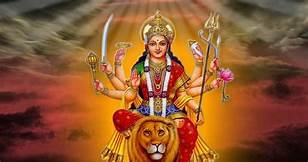
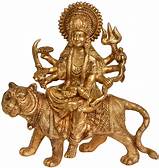
RITUAL WORSHIP
Worship of goddess Durga signifies the process by which the divine potential within every being removes its layers of ignorance and achieves the state of self-realization. Hindus celebrate this occasion at an auspicious time every year to constantly remind themselves of the significance of this very process. They contemplate the progress made on their spiritual journey and celebrate with great joy the victory of the supreme consciousness over the demons of ignorance. The Navaratri (Durga Puja or Dusshera) festival is also a reminder that evil can never triumph over the power of truth.
Offerings, Rituals and Pooja
Durga Puja (Navaratri or Dusshera) is the greatest Hindu festival in which God is adored as Mother. Hinduism is the only religion in the world, which has emphasized to such an extent the motherhood of God. Perhaps the greatest testament to the power of Durga Puja is that even today the Mother is worshipped by billions of Hindus worldwide in exactly the same manner as she was thousands of years ago.
At the Durga Puja, the most important festival of Durga, she is shown with four other deities – usually smaller in size than that of goddess Durga. Two deities are placed on each side of the main idol of goddess Durga. These deities are Kartikeya, Ganesha, Saraswati, and Lakshmi, who are commonly identified as her children. The festival of Durga Puja usually involves beautiful and larger than life clay idols of Durga and her accompanying deities.
The four days (beginning with the sixth day after the last new moon before the festival) of the festival is actually representative of the home-coming of goddess Durga along with Kartik, Ganesha, Saraswati and Lakshmi. The deities are presented with offerings throughout the festivities. On Vijayadasami, the “Victorious Tenth Day,” the idols are taken in a parade to a river or tank and immersed as a representation of bidding a tearful goodbye to the deities. This is usually a very emotional time for devout Hindus who accompany the idols to the immersion spot.
The same day sees millions of Hindus also celebrate the festival of Dusshera which marks the end of evil, as depicted by the burning of huge effigies of Ravana, Kumbhakarna and Meghnad – the three demon brothers, where among them Ravana is the king of demons. All three were defeated by Lord Rama on this day.
Other forms of festivities during the period preceding Dussehra or Vijayadashami also exist, the most popular being that of the Navaratri festival, which involves the propitiation of Goddess Durga in nine different forms called the Nava-Durga, over the nine days preceding Dussehra and starting on the first day after the last new moon preceding Dusshera. During Navaratri, each of these nine forms of goddess Durga is worshipped on a particular night for the destruction of evil and for the preservation of Dharma.
BENEFITS OF WORSHIP
Maa Durga, the inaccessible one and the invincible one, is believed to be the “one who can redeem in situations of utmost distress”.
Durga is not only a powerful force for cosmic order but also a protector of her devotees. She listens to her devotees and attends to their needs. She is a personal savior who will save her devotees from forest fires, wild animals, robbers, imprisonment, execution, and battle.
Durga symbolizes unity even in the psyche of man. Her fight against Mahisha symbolizes the fight against the darkness of evil and the ultimate victory of good over evil. This victory is not only physical in nature but also implies the inner struggle faced every day by man in all fields of his life. This struggle aims to reach man to the highest levels of Sattva or pure consciousness, where his soul meets the One Universal Soul, embodied by Durga Herself.
The seeker then reaches a state of complete bliss, which can be attained only after eliminating the base emotions or Rajas. The base emotions are embodied by the lion, which is forever under the control of the Goddess. Thus, only surrendering the mind and letting the Devi take over it, can free the seeker of this material world and grant him or her a permanent state of bliss.
The fight between Durga and Mahisha actually symbolizes our internal fight between good and evil. The slaying of Mahisha is actually the slaying of the Tamas or the impure lying within all of us.
Durga, the Mother Goddess is the symbol of all the auspicious and true qualities which define the Supreme Being. Of all her forms, Devi Durga is the ultimate representation of infinite power, purity and strength of purpose, which resides within the divine essence of every being.
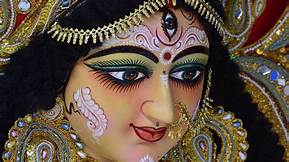

MANTRA OR SLOKA FOR INVOCATION
Mahishasuramardhini Stotram (Slokam)
“Ayi girinandini nanditamedini
Vishvavinodini nandan Krittibasute|
Girivara vindhya shirodhinivaasini
Vishnuvilaasini jishnunute|”
O, Daughter of the Mountain, the One who brings joy to the whole Earth, who makes the entire Universe rejoice, the One praised by Nandin, residing on the peak of the great Vindhya mountain; You are praised by all those desirous of victory.
The above are the first 4 lines of the Mahishasuramardhini Stotram, a hymn on the highly adored, worshipped and celebrated Devi Durga.
Durga Mantra
“Sarva Mangala Mangalye, Shive Sarvatha Sadhike
Sharanye Tryambake Gauri, Narayani Namo-Stute”
Meaning: “Auspiciousness of all things auspicious! O consort of Shiva, fulfiller of all our goals! Our only refuge! O three eyed Gauri! O Narayani! Our salutations to you.”
Mantra Benefit
This mantra is recited almost during all celebrations, rituals and events. Regular chanting can give wisdom and strength combined with a prosperous life.
SPECIAL DAY OR FESTIVAL
Auspicious Day
Durga Ashtami- The Eighth Day of Navaratri Festival
Ashtami, in particular, is celebrated with great passion and fervor. Ashtami marks the eighth day of the festival and on this auspicious day, devotees tend to observe rigorous fasts, feast and worship for Goddess Durga who symbolizes strength. A celebration of traditional culture and customs, massive idols of Goddess Durga are installed throughout India while enormous puja pandals are set up at various places for devotees to visit and worship.
Friday is dedicated to Mother Goddess – Durga Maa and Mahalakshmi, Santhoshi Ma, Annapuraneshwari. The planet associated with this day is Venus. Sweets are distributed on the day. Those fasting on the day are allowed to eat at night.
Important Festivals
Maa Durga is worshipped all over India especially during the Navaratri festival (nine nights and ten days); in India it starts on the new moon day between September and October 15th. Nine forms of Shakthi Devi are worshipped then. She is worshipped in many countries in Asia.
Source: Halinka Bykowska
In North India, the tenth day of Navratri signifies Lord Rama’s victory over the demon King, Ravana. Ram Lila sessions are conducted, wherein artists enact the story of Rama and straw effigies of Ravana are burnt in designated open spaces.
In Gujarat, the Garba dance is performed with great vigour, in order to celebrate the Goddess’ victory over Mahisha. In Maharashtra, Ambabai and Tulja Bhavani are worshipped as forms of Mahishasuramardhini.
In Tamil Nadu, people keep the Golu (or Kolu), which is a certain arrangement of dolls, and offer prayers, flowers, fruits, incense and naivedya to the deity. Women then call their female friends over for the distribution of haldi-kumkum. This is a predominantly ladies’ festival, signifying that each woman is an aspect of the Sacred Feminine.
In Bangladesh, there is a four-day long Sharadiya Durga Puja. This is celebrated with great religious fervour by all Hindus residing there.
The Durga Puja in Bengal
The Navratri festival, though, is celebrated with the most devotion and fervour in Bengal, where Goddess Durga is considered the Supreme Almighty. The four-day Durga Puja ceremony, starting from the Saptami (seventh day) to the Dashami (tenth day) is the greatest annual festival in Bengal. All through the period of the Navaratri, the Navadurga or nice aspects of Durga are meditated upon, each Devi being worshipped on one particular day of the Navratri. This type of worship is especially undertaken by Shaktas or Shakti worshippers.
See more in the tab: RITUAL WORSHIP.

-
[12] 5.0 - 5.5.1 >Prakarams of Mukthi Stupi
- 5.0.1 - Apsaras
- 5.1 - First Prakaram of Stupi
- 5.2 - Second Prakaram of Stupi
- 5.2.1 - Sri Sathya Sai Baba Padukas
- 5.3 - Third Prakaram of Stupi
- 5.3.1 - Sri Kakabhujandar
- 5.3.2 - Sri Bahula Devi
- 5.4 - Fourth Prakaram of Stupi
- 5.5 - Fifth Prakaram of Stupi
- 5.5.1 - Mukthi Stupi
-
[18] 101-109 >Munis & Consorts-part B
- 101.0 - Kutsar
- 101.1 - Anugraha Devi
- 102.0 - Roma Rishi
- 102.1 - Prema
- 103.0 - Adi
- 103.1 - Anupama
- 104.0 - Shukracharya
- 104.1 - Sukeerti
- 105.0 - Durvasar
- 105.1 - Indira
- 106.0 - Angirasar
- 106.1 - Akshaya Devi
- 107.0 - Pulasthiyar
- 107.1 - Rama Devi
- 108.0 - Pulaha
- 108.1 - Manohari
- 109.0 - Vyagrapada
- [12] 5.0 - 5.5.1 >Prakarams of Mukthi Stupi
- 5.0.1 - Apsaras
- 5.1 - First Prakaram of Stupi
- 5.2 - Second Prakaram of Stupi
- 5.2.1 - Sri Sathya Sai Baba Padukas
- 5.3 - Third Prakaram of Stupi
- 5.3.1 - Sri Kakabhujandar
- 5.3.2 - Sri Bahula Devi
- 5.4 - Fourth Prakaram of Stupi
- 5.5 - Fifth Prakaram of Stupi
- 5.5.1 - Mukthi Stupi
-
[18] 101-109 >Munis & Consorts-part B
- 101.0 - Kutsar
- 101.1 - Anugraha Devi
- 102.0 - Roma Rishi
- 102.1 - Prema
- 103.0 - Adi
- 103.1 - Anupama
- 104.0 - Shukracharya
- 104.1 - Sukeerti
- 105.0 - Durvasar
- 105.1 - Indira
- 106.0 - Angirasar
- 106.1 - Akshaya Devi
- 107.0 - Pulasthiyar
- 107.1 - Rama Devi
- 108.0 - Pulaha
- 108.1 - Manohari
- 109.0 - Vyagrapada
